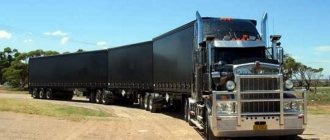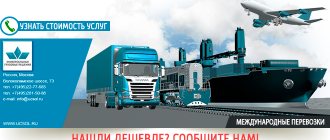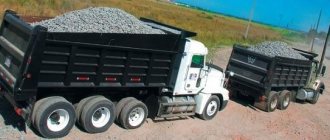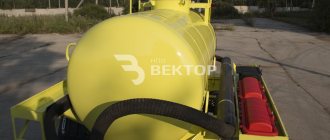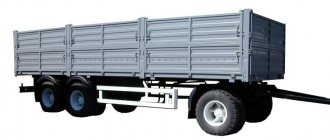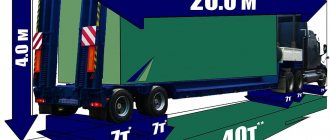Requirements regarding transportation are established by traffic rules
Transportation must be carried out by special transport. In this case, the following conditions must be met:
- the weight of the transported cargo cannot exceed the maximum permissible values established by the vehicle manufacturer;
- It is prohibited to operate a vehicle that has partial or complete obstruction of headlights and registration plates;
- the product must not interfere with the visibility and control of the vehicle.
Maximum permissible dimensions for vehicles in the Russian Federation
Classification of cargo by loading method
To know how to load a product, you need to know its class according to the loading method.
According to the loading method, the goods are divided into:
- bulk;
- bulk;
- piece.
Bulk
Bulk cargo includes those that are loaded without containers. These include coal and cereals, snow and gravel, cement, potatoes. The peculiarities of this type of cargo are the large labor costs for loading and unloading.
To prevent small particles from spilling onto the road, blowing out fine particles and getting wet, the load is covered with a canopy.
Bulk
Tanks and tank containers are used to transport liquid cargo. In turn, liquid cargo is classified
- by viscosity: water, oil, bitumen;
- by hazard class: oil, acid;
- according to delivery temperature conditions: asphalt, milk.
For transportation of each type, use its own container. Transportation of food products requires strict compliance with sanitary rules and temperature conditions. Containers containing explosive liquids require grounding.
Aggressive substances should be transported in containers with a special coating.
When transporting liquids transported by road, tank filling standards must be observed. Sharp braking when the tank is partially filled causes a decrease in vehicle stability and controllability.
Piece
Piece cargo is divided into containerized and bulk cargo. Bulk - not requiring special packaging - pipes, logs. Packaging of transported goods prevents their damage. Most piece goods are transported in containers.
Based on strength, containers are divided into:
- hard;
- semi-rigid;
- and soft.
Rigid containers are boxes, containers, boxes, barrels. They are usually made of wood, plywood, durable plastic, and reinforced at the joints and along the bottom with metal plates. Semi-rigid containers are cardboard boxes, baskets, rolls. Soft containers are bags and bales.
Piece cargo includes tractors and boats, machine tools and equipment - everything that can be loaded in separate units. Transportation of piece goods is different in that different types of goods can be loaded into one car or wagon.
An enlarged cargo unit is also a piece cargo. Such cargo units are formed from piece cargo using pallets, slings, strapping, ties and other devices. The use of enlarged cargo units significantly reduces loading and unloading time.
Dimensions that have dimensional transportation objects
Dimensions of transported cargo (maximum permissible):
- width – 2.65 m;
- length – 22 m;
- height – 4 m;
- vehicle weight – 38–40 tons.
Permitted height of transported cargo
According to the influence of the external environment, cargo is divided into sensitive and non-sensitive
Non-mode ones do not depend on the influence of the external environment. Regime ones require certain values of humidity and temperature to preserve their qualities. Special cargo - dangerous, live, perishable - requires a special delivery mode.
Loading one transport unit with goods of different classes is possible if data on their properties is available. It is possible to contain cargo together if their joint transportation or storage does not cause damage or change in their characteristics.
It is prohibited to store and transport at the same time:
- moisture-intensive and with high humidity;
- quickly absorbs foreign odors and has a strong smell;
- food and poisonous substances;
- refrigerated foods and those that cannot stand the cold.
Characteristics of oversized cargo
The dimensions and weight of many types of goods exceed the maximum permissible limits. Their transportation is permitted, but is regulated by traffic rules.
Proper transportation of oversized cargo
Depending on how much the characteristics of the transported items differ from the permissible ones, the conditions for allowing equipment on the roads differ. If the luggage being transported protrudes from the rear beyond the vehicle by a distance of up to one meter, and across the width of the vehicle by 0.4 m, a “Large Load” sign should be posted, white lights and reflectors installed in the front and red ones in the rear.
If the transported objects protrude from the rear of the truck by more than 2 m, and the height of the object exceeds 4 m, special rules established by the Government and the Ministry of Transport apply.
Maximum automotive standards in Europe
The maximum permissible dimensions and weight of cargo for through and enclosed road transport are regulated by both national legislation and international multilateral agreements - conventions and directives. The requirements for such parameters are strictly and unambiguously established, since, as stated in EU Directive No. 96/53, “differences between existing standards regarding the weight and dimensions of commercial vehicles may have a negative effect on competition and act as an obstacle to transport between member states of the European Union.” Union".
Precise information on the maximum weights and dimensions of vehicles adopted in the countries of the European Community is given in the annexes to the directive:
| length from front to rear bumper | for a solid frame truck – 12 m |
| for a road train – 18.75 m | |
| body width | general requirement – 2.55 m |
| for isothermal vans – 2.6 m | |
| truck height | no more than 4 m |
| weight indicators | for two-axle machines – 18 t |
| for three-axles – 24 t | |
| for vehicles with five and six axles – 40 t |
List of rules for transporting large items
What do the rules for transporting oversized cargo require:
How to attach a “Large Load” sign
- preliminary approval of the route;
- obtaining a special permit for transportation;
- use of escort vehicles;
- in case of damage to elements of transport infrastructure, the carrier must compensate for the damage.
For transportation of large-sized cargo, a “Large cargo” sign must be attached to a protruding point. It is made of reflective materials. The sign is a square with sides measuring 40 cm, on which there are inclined stripes of red and white colors (their width is 5 cm). You can make it yourself or purchase it ready-made.
In addition, it may be necessary to fix the white and red side lights.
How to “hide” excess?
When transporting, it is of great importance what kind of transport is used for this. And if you choose the right car, you can move freely from the starting point to the final point without classifying the cargo as oversized.
For example, it is necessary to transport a container with a height of 3.1 m. In this case, the permissible height dimensions of cargo for transportation by road are 4 meters. If a container ship or flatbed trailer of the scow type is used, the height of the item to be delivered is greater. However, if the carrier loads it onto a low-loader trawl, the container will “fit” into the established standards and will be considered oversized. This also affects the cost of transportation, since in the second case there is no need to obtain a special permit or use cover vehicles to transport large cargo.
A similar solution is proposed for the transportation of horizontal cargo, which goes beyond the scope of the term “oversized”. For example, a container 16 m long does not fit on a standard scow, and then a sliding semi-trailer is used. This helps to “hide” extra meters.
For transportation by cars and private vehicles
Rules on the overall dimensions of cargo permitted for transportation by road transport apply not only to specialized companies and entrepreneurs providing services in this area. They must also be observed by owners of individual passenger vehicles that are used for their own purposes.
Special rules apply for the transportation of oversized cargo. Ignoring the requirements regarding the maximum permissible size of transported items is punishable by a fine and other sanctions. Motor transport companies and private carriers must understand that if the dimensions exceed the established standards, the transporter, along with the transported goods, may end up in an arrest area, and a fine will be imposed on those responsible.
Documents permitting transportation
When preparing the goods and choosing a vehicle, you should be guided by the following documents:
- Decree of the Government of the Russian Federation No. 272.
- Order of the Ministry of Transport of the Russian Federation No. 258.
- Order of the Ministry of Transport of the Russian Federation No. 7.
- Traffic rules.
What to consider:
In accordance with regulations, attention should be paid not only to the direct transportation of the product, but also to its installation and fastening. Maintaining the stability of the car during movement is ensured, among other things, by placing heavier luggage at the bottom, maintaining its uniformity and the quality of its fastening. Gaps between individual goods are not allowed; they must be filled with special spacers.
Types of oversized cargo
If single places are installed, when stacking them, ensure the same number of tiers and securely fasten the top one.
If increased danger arises during the transportation of large goods, it is necessary to attract escort vehicles, which can be tractors or traffic police vehicles.
Transportation recommendations
When obtaining permission to transport large cargo, full compliance with the rules must be ensured, which exclude:
Transportation of large cargo
- deviation from the permitted route;
- exceeding the established speed limit;
- driving in poor visibility, ice, snowfall;
- movement along the sides of the roadway;
- stopping outside special parking areas;
- transportation in the event of displacement of goods, loosening of fasteners, as well as in the event of a malfunction of the vehicle.
If circumstances arise that require changing the transport route, the carrier must obtain a new travel permit.
Drawing conclusions
Freight transportation is a service without which the development of any sector of the national economy is impossible. It is no coincidence that the organization of traffic on roads requires increased attention.
Transportation of large and heavy cargo should be carried out in compliance with all norms and legal requirements. After all, the slightest mistake or violation of the rules when working with such cargo entails serious consequences - from damage to cargo and vehicles to injury and death of road users in an accident.
Do you need to move an oversized shed or pavilion? Finding a suitable manipulator in the company’s extensive fleet is not a problem!
Call or write to the manager - a specialist will make sure that when transporting oversized cargo, all requirements and norms of Russian legislation are met
Procedure for obtaining a permit for a vehicle
To obtain a permit for transportation, you should contact the appropriate organization, depending on the subordination of the road along which the transportation will be carried out.
Permits are issued by the following authorized bodies:
Special permit for the transportation of goods across the territory of the Russian Federation
- Rosavtodor , in case of movement on federal roads or highways along which international traffic is carried out.
- The executive body of a constituent entity of the Russian Federation when traveling on intermunicipal or regional roads.
- By the self-government body of the municipality , if it is planned to move the vehicle along a local highway within the boundaries of 1 district.
- By the self-government body of the settlement , in the case of a local road passing within the boundaries of one settlement.
- City government when the route is laid along a local city road.
To consider an application, you must provide documents for the car, a detailed description of what the car is carrying, and a diagram of the intended movement.
Step-by-step scheme for obtaining a transportation permit
Rationing of trucks in the Russian Federation
As for the Russian Federation, Federal Law No. 257 “On Highways and Road Activities” is in force here, as well as the Government Decree dated April 15, 2011. No. 272. Paragraph 2 of this by-law states that road transportation of goods in international traffic across the territory of Russia is carried out in accordance with international treaties and Russian laws. Of greatest interest are the 1st and 3rd appendices concerning the permissible weight and maximum dimensions of cargo.
Thus, Appendix 1 establishes permissible masses depending on the type of vehicle, combination of cargo platforms and the number of axles. In the table below, the maximum weights are given in tons:
| single cars | 2-axle – 18 |
| 3-axle – 25 | |
| 4-axle – 32 | |
| 5-axis – 35 | |
| semi-trailers and trailed road trains | triaxial – 28 |
| four-axle – 36 | |
| five-axle – 40 | |
| with six or more axles – 44 |
Appendix 3 is devoted to the maximum dimensions:
| length from front to rear bumper | for a single vehicle and trailer – 12 m |
| for a road train – 20 m | |
| body width | general requirement – 2.55 m |
| for isothermal vans – 2.6 m | |
| truck height | no more than 4 m |
It follows that the heaviest and largest truck that is allowed to be rolled out on domestic roads, in any case, should not weigh more than 44 tons and have a length of more than 20 and a height of more than 4 meters. Otherwise, there is oversized cargo.
Penalties
Violation of cargo transportation rules is fraught with administrative sanctions. The vehicle along with the cargo is transported to the penalty area. Drivers transporting goods subject to a permit in violation of the rules face a fine of up to 10 thousand rubles and deprivation of a driver’s license for up to 4 months; legal entities may be subject to fines of up to 500 thousand rubles.
Video on the topic: Cargo transportation
Publications on the topic
Rules for issuing a power of attorney for cargo transportation
How is transport tax calculated on a car?
Volvo FH16 - the best modern tractor for long-distance transport
Liability and fines
In case of violation of the rules and requirements for the transportation of oversized cargo, the law provides for administrative liability for the following categories of persons:
- individual (driver) – a fine in the amount of 1000 to 5000 rubles, as well as deprivation of a driver’s license for a period of 2 to 6 months;
- official - 5,000-20,000 rubles;
- legal entity – 150,000 to 500,000 rubles.
The amount of the fine depends on the type and extent of the violation.
Lifting and moving standards for men
Statistics claim that the special rhythm of life and work of today's people is directly related to excess stress, both emotional and physical. Data show that a third of people living on earth suffer from spinal diseases. Many modern professions involve lifting and carrying heavy objects. To preserve health and long-term work function, labor protection measures have been developed in this area. Experts have calculated, and legislators have approved acceptable standards for moving heavy objects manually.
Carrying norm
For the strong half of humanity, the weight of a single lifting load should not exceed 50 kg, with a transportation range of 25 m. If an object weighs up to 80 kg, it can, if necessary, be lifted and carried manually, but only by two people at a time.
For your information! Typically, loads weighing more than 50 kg are lifted and moved by mechanization; during the production process, the weight limit is 20 kg.
To determine the lift mass standard, the operating mode is taken into account. Lifting may be the primary function during the workday or may be interspersed with other tasks. It's worth considering both options.
The maximum permissible load on a person’s muscles when lifting or carrying a load at one time when performing several labor operations is:
- light load - optimal conditions (not having harmful or dangerous effects on humans) - up to 15 kg;
- medium load - acceptable conditions (the level of adverse effects corresponds to the norms, functional restoration of the body occurs subject to the rules of alternating work and rest) - up to 30 kg;
- heavy load - harmful conditions of the first degree (exposure to harmful and dangerous influences leads to changes in body functions, the restoration of which requires a longer time, there is a risk of damage to health) - up to 35 kg;
- heavy load - harmful conditions of degree II (hazardous working conditions leading to the possibility of getting an occupational disease of the initial form after long-term employment of 15 or more years) - up to 50 kg.
Norm for men
In all cases, lifting is permitted no more than twice per hour.
If lifting and carrying weight is the main and only function during the entire working time, then the maximum load for one lift must comply with the following standards:
- light load - optimal conditions - up to 5 kg;
- medium load - permissible conditions - up to 15 kg;
- heavy load - harmful conditions of degree I - up to 20 kg;
- heavy load - harmful conditions of degree II - from 20 to 30 kg.
Important! The concept of cargo mass includes weight in containers or packaging, which is significantly different from the concept of net.
In addition to standards for the weight of lifting weights, there are standards for carrying loads.
When carrying rigid packaging, protective gloves are used. Sharp and prickly loads must be lifted and carried in covers and cases. Long loads are allowed to be carried only by a few workers, on the same shoulder (left or right). Raising and lowering occurs only at the command of a senior. The transfer of heavy loads by a group of people should be carried out in such a way as not to cause injury to each other. Moving with a heavy object in your hands occurs along a short, clear path; overtaking the person in front is unacceptable. You cannot climb a flight of stairs with a stretcher and materials in it. Glass bottles with acids and other liquids are transported only in wicker or lattice containers by two workers. Carrying bottles on your back, shoulder, or in your hands in front of you is unacceptable. Gas cylinders must be transported only with the use of auxiliary equipment.
Posture when lifting weights
And another important point: you need to learn how to lift a load safely. To do this you need to follow simple rules:
- before starting the act of lifting, you need to acquire a stable posture;
- the lower body position is achieved by bending the legs at the hip and knee joints;
- posture remains invariably straight;
- lifting occurs slowly due to extension of the legs;
- pressing the load to the body eases the load on the back;
- You need to hold the object with both hands;
- when carrying weight, the step should be short and unhurried;
- Can be carried on the back.
Cargo of special value
Also one of the classes includes cargo of special value. It can be:
- precious metals, products made from them;
- antiques;
- artifacts;
- rare animals, plants;
- works of art;
- securities;
- collections, museum exhibitions.
Transportation conditions may require a special environment in a container with cargo and a trained attendant. In addition to creating special conditions for transporting valuables, complete security must be ensured.
A special route may be drawn up and armed guards assigned. Insurance of the transported object, availability of accompanying documents, and appropriate markings are mandatory. If the client does not have documents for valuables, the carrier has the right to refuse to provide the service.
Views: 21,800
Features of labor protection for minors
Standards for cleaners according to the Ministry of Labor
Labor protection legislation pays special attention to the younger generation. And although employment is permitted from the age of 14, there are various restrictions and prohibitions on the use of labor by persons under 18 years of age.
Norms for a teenager
It is unacceptable to accept minors to perform labor functions with dangerous and harmful indicators, to work underground, and possibly cause harm to physical and moral health. Manual labor associated with lifting and carrying weights exceeding permissible standards is prohibited.
The developed parameters allow the following load:
| Employee category | Full time job | 1/3 shift | Cargo weight per shift | ||
| Constantly, more than 2 times per hour | Alternating with other activities up to 2 times per hour | Lifting from the surface | Lifting from the floor | ||
| Boys: - 14 years old - 15 years old - 16 years old - 17 years old | 3 3 4 4 | 6 7 11 13 | 12 15 20 24 | 400 500 1000 1500 | 200 250 500 700 |
| Girls: - 14 years old - 15 years old - 16 years old - 17 years old | 2 2 3 3 | 3 4 5 6 | 4 5 7 8 | 180 200 400 500 | 90 100 200 250 |
There are other features of employment of minors.
Regardless of the nature of the work performed, before concluding an employment contract, young people aged 14-17 years are required to undergo a preliminary medical examination, and repeat it annually until they turn 18 years old. The examination is paid for by the employer. This category of working citizens cannot be sent on business trips or engaged in work at night, weekends and holidays. The only exceptions are cultural sectors, where the list of professions involved in activities outside working hours is approved by the Government of the Russian Federation. The production rate of teenagers is reduced in proportion to the decrease in working hours. If there are established standards in local regulatory acts, production for young people under 18 years of age may be reduced. Annual basic paid leave is provided on a general basis at a time convenient for the minor, lasting 31 calendar days.
Important! An employee under the age of 18 can be dismissed only on his own initiative, as well as in connection with the liquidation of an organization or individual entrepreneur. Other grounds are agreed with the labor inspectorate and the commission for minors.
What kind of cargo can be lifted and moved by a crane?
A site will be equipped for the work. The boundary of the service area of tower cranes is determined by the radius of the maximum radius of the boom. The equipment is supplied with a metal plate indicating the following information:
- name of the manufacturer;
- load capacity;
- Date of issue;
- Serial serial number.
According to safety regulations, the weight of loads lifted by cranes should not exceed the rated load capacity. If the weight of the object being moved is unknown, work is suspended until the actual value is determined.
When performing work, the crane must be in a stable position. It is prohibited to hang a structure or container by one horn of a double-horn hook. Pushing a moving object along the ground, floor or rails with a equipment hook in an inclined position is carried out using cargo ropes using guide blocks. The cranes' load lifting mechanisms ensure a vertical position. Also, special tools and equipment are used when lifting containers or structures from the installation site.
It is prohibited to move people with a crane. But there are exceptional cases when the operating instructions for a lifting machine allow such operations. A specially designed and manufactured cabin is used to ensure the safety of people. The work is coordinated with the state city technical supervision authorities.
Occupational safety for pregnant women
A woman carrying a child should be provided with easier and safe working conditions. From the moment a medical report and application is provided to the employer, adverse production factors affecting pregnancy must be reduced to an acceptable level and production standards reduced. If it is impossible to provide easier working conditions at their main place of work, women are provided with other safe work while maintaining the average earnings for their previous employment.
SanPiN: noise standards, level in the workplace
As for lifting heavy objects, the weight of the objects being lifted, the height of the lift are reduced and the position of the woman’s body is corrected. It is prohibited to lift objects above the shoulder line and from floor level. The tilt of the torso cannot exceed 15°; constant tension in the muscles of the legs and abdomen is unacceptable. Lifting standards for women are significantly reduced:
| Name of technological operation | Weight of lifted object (kg) |
| Lifting and carrying heavy objects as a non-permanent labor process | 2,5 |
| Lifting and carrying heavy objects as the main function during the shift | 1,25 |
| The total mass of the load moved during operation over a distance of 5 m, when alternating operations from the working level, from the floor | 60 prohibited |
| Total mass of cargo moved per shift from the working surface | 480 |
There are also general restrictions on the work of pregnant women. The legislator prohibits an employer from engaging women expecting the birth of a child to work at night, on weekends and holidays, or sending on business trips. Working outside the norm is not acceptable.
If there is a doctor's conclusion, a pregnant woman is allowed to work part-time; for this purpose, the length of the working day or week is reduced. The provided benefit does not affect the number of days of annual paid leave, calculation of length of service and other rights. Remuneration corresponds to hours worked. An employer does not have the right to refuse employment due to pregnancy. Dismissal of expectant mothers at the initiative of the enterprise is prohibited.
Note! The only exception to the rules can be the liquidation of an organization or termination of the activities of an individual entrepreneur. At the end of a fixed-term employment contract during pregnancy, the woman is required to extend it until the birth, and if the expiration date of the contract coincides with maternity leave, then until its end. The pregnancy status is confirmed by a medical report.
